UT-Austin, Tsinghua University Pursue International Collaboration for Green Space
Beijing project to be paradigm for other urban areas
by Tracy Ostroff
Contributing Editor
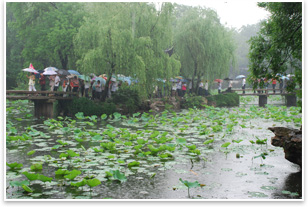 How do you . . . work collaboratively and engage students to tackle problems of urbanization? How do you . . . work collaboratively and engage students to tackle problems of urbanization?
Summary: Architecture faculty and students at the University of Texas at Austin are partnering with Tsinghua University in Beijing to bring green space into a neighborhood outside the fast-growing, densely populated city. The international collaboration brings together faculty and students from both universities to explore an interdisciplinary approach to designing traditional green retreats or “pocket parks,” in a large, complex urban area between Tsinghua University and the Forbidden City in central Beijing.
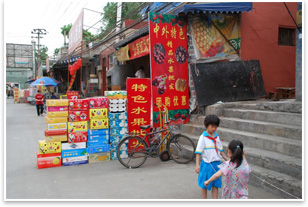 Beijing’s “dizzying growth and deep culture provide an ideal urban laboratory for our studio,” says Fritz Steiner, dean of the University of Texas at Austin School of Architecture and visiting professor at Tsinghua University. Although the urban studio is tailored to Beijing, the team hopes the lessons they learn can be applied to creating pocket park networks in other cities, including Austin. Beijing’s “dizzying growth and deep culture provide an ideal urban laboratory for our studio,” says Fritz Steiner, dean of the University of Texas at Austin School of Architecture and visiting professor at Tsinghua University. Although the urban studio is tailored to Beijing, the team hopes the lessons they learn can be applied to creating pocket park networks in other cities, including Austin.
The goal of the project, say university organizers, is to propose a network of small, inner-city parks that can exist within new developments and mature urban conditions. The approximately 150-acre site is a challenging area with residential, commercial, and institutional functions, bounded by transportation arteries. UT students and faculty spent a week and a half in Beijing in May for a site visit. This fall, the urban studio expects to host a team of 8-10 students from the architecture school at Tsinghua University.
Students get value from collaboration
The project is also a learning collaboration among UT’s architecture studios. Fifteen students from the areas of community and regional planning, landscape architecture, and architecture are working together in five teams to develop conceptual plans for the project. Once a final design is chosen, students will focus on their specific areas of expertise to bring the design to fruition. “Their different perspectives and competitive spirit” are propelling the project forward and teaching the students how to work in a team environment, says Wilifred Wang, professor in the school of architecture at UT.
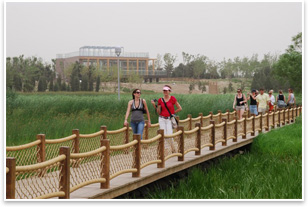 “International projects are extremely important for a student, because they get to work in a completely different culture, get to see a completely different traditions of building, and different traditions of urbanism, and that’s very valuable for a student’s education,” Steiner told a local Austin news station in July. “International projects are extremely important for a student, because they get to work in a completely different culture, get to see a completely different traditions of building, and different traditions of urbanism, and that’s very valuable for a student’s education,” Steiner told a local Austin news station in July.
As of now, they do not have a client, it is only a class exercise. An environmental impact analysis will be conducted to review varying modes of transportation to and from the parks, occupancy rate in the parks, and evaporative cooling provided by the addition of a tree canopy. They have spoken with local planning agencies, which the organizers say are eager to review the data students collect and see their plans to develop green space.
Protecting culture, promoting environment in Beijing
“Foreign eyes often offer fresh views on many old urban problems … this is a truly international approach to the global problem of rapid urbanization,” says Ming Zhang, assistant professor of community and regional planning in the School of Architecture at the University of Texas at Austin and alumnus of the Architecture School at Tsinghua University, who was part of the group to tour the Forbidden City.
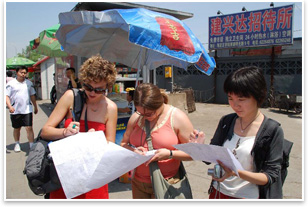 The students have been asked to take areas called “super blocks,” the 20-block self-sufficient areas that have become entities unto themselves, in which a person may live, work, and recreate. Some super blocks, Zhang, a Tsinghua University graduate, explains, contain factories or other workplaces. They are not, however, well integrated with each other, and sometimes impose barriers to movement among different areas of the city. The students have been asked to take areas called “super blocks,” the 20-block self-sufficient areas that have become entities unto themselves, in which a person may live, work, and recreate. Some super blocks, Zhang, a Tsinghua University graduate, explains, contain factories or other workplaces. They are not, however, well integrated with each other, and sometimes impose barriers to movement among different areas of the city.
By studying ways to improve pedestrian and non-vehicular access among and within the super blocks and to guide an eight-lane highway through a network of public spaces, they are hoping to improve the micro-economies, develop culturally sensitive green spaces, and improve air quality and other environmental factors for the city district. They seek to recover green spaces and create ideas for how they can build on the Chinese tradition of green areas, Steiner says.
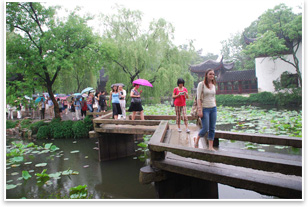 Understanding context through travel Understanding context through travel
“One must actually visit the site to be able to appreciate the cultural context and witness the incredible rate of change,” Steiner says. The real educational value was the ability to study and experience firsthand the deep history and culture that is Beijing and visit the traditional courtyard gardens that the project is aiming to conjure, protect, and celebrate. The group of students and faculty also traveled south of Beijing to imbibe different notions of Chinese landscape design, which, Steiner says, in the Western world are not well understood and are being threatened by the population increase and development.
Wang notes that the prestigious Tsinghua University collaborates with many other universities, including through a longstanding relationship with the Massachusetts Institute of Technology. But, he says, UT’s partnership with the Chinese university is unique, because the Tsinghua students will have the funds to travel to the U.S. to experience culture in Austin. Usually, lack of funding prevents them from traveling abroad. Wang says they are keen on doing other projects with the university.
| 

 How do you . . .
How do you . . . Beijing’s “dizzying growth and deep culture provide an ideal urban laboratory for our studio,” says Fritz Steiner, dean of the University of Texas at Austin School of Architecture and visiting professor at Tsinghua University. Although the urban studio is tailored to Beijing, the team hopes the lessons they learn can be applied to creating pocket park networks in other cities, including Austin.
Beijing’s “dizzying growth and deep culture provide an ideal urban laboratory for our studio,” says Fritz Steiner, dean of the University of Texas at Austin School of Architecture and visiting professor at Tsinghua University. Although the urban studio is tailored to Beijing, the team hopes the lessons they learn can be applied to creating pocket park networks in other cities, including Austin.

 Understanding context through travel
Understanding context through travel